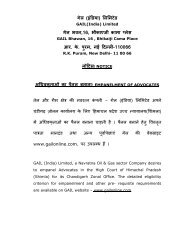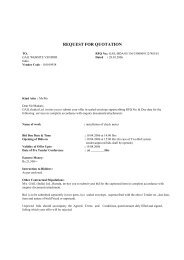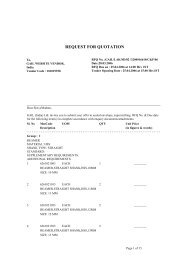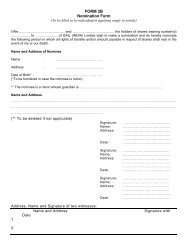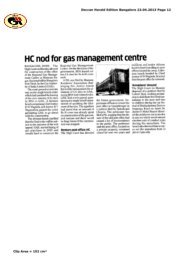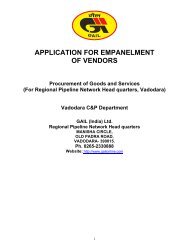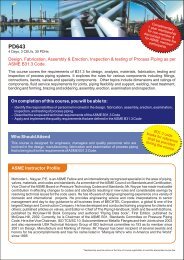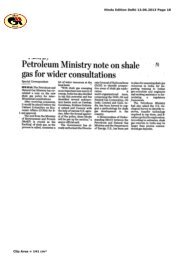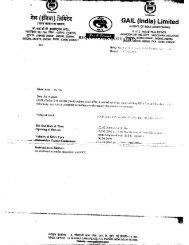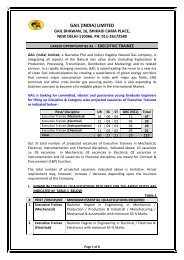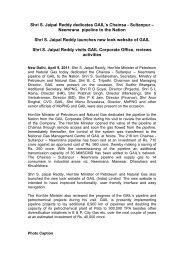GAIL (India) Limited
GAIL (India) Limited
GAIL (India) Limited
- No tags were found...
Create successful ePaper yourself
Turn your PDF publications into a flip-book with our unique Google optimized e-Paper software.
262. Test for organic impurities.3. Decantation test for determining clay and silt content.4. Specific gravity test.5. Test for unit weight and bulkage factor.6. Test for sieve analysis and fineness modulus.Tests on coarse aggregates shall include1. Sieve analysis.2. Specific gravity and unit weight of dry, loose and rodded aggregate.3. Soundness and alkali aggregate reactivity.4. Petrographic examination.5. Deleterious materials and organic impurities.6. Test for aggregate crushing value.Any or all these tests would normally be ordered to be carried out only if the Engineer feels thematerials are not in accordance with the specifications or if the specified concrete strengths are notobtained and shall be performed by the Contractor or at an approved test laboratory at the cost of theContractor.If the work cubes do not give the stipulated strengths, the Engineer reserves the right to ask theContractor to dismantle such portions of the work which, in his opinion, are unacceptable and re-do thework to standards stipulated, at the Contractor's cost. The unit rate for concrete shall be all inclusive,including making preliminary mix design and test cubes works, cubes, testing them as perspecification, slump tests, optional tests etc.,3.27 Concrete for Equipment or steel structures foundationsConcrete for equipment foundation, whether principal or auxiliary, shall be poured continuously so thatthe structure becomes monolithic, particular care being exercised to see that the base slabs, if any, areof compact impervious construction. Tunnels, passages, apertures and so forth shall be provided inaccordance with the drawings for the installation of mechanical and electrical equipment, pipes orcables. The top elevation of the equipment foundations or parts shall be accurately cast to 20/50 mm(or more as may be specified on the drawings) above the level required for grouting and it shall bepneumatically chiseled off and well roughened just prior to the erection of the equipment concerned.All embedded anchor bolts or bolt sleeves shall be accurately and firmly set with the aid of approvedtemplates, steel supports and/or other accessories. For holding the embedded bolts or sleeves in thecorrect position during concreting, template shall have to be of steel of suitable section approved by theEngineer. Two sets of templates shall have to provided, one to hold the bottom and the other the top ofthe bolts or sleeves. The bottom template shall be securely and rigidly fixed by providing anchoragearrangement and by welding to the lowest part of the steel reinforcement and other structural supports.The top templates shall be securely fixed by tying with guy wires and turn buckle arrangements to firmand rigid adjoining structures and staging. The bottom template that is embedded in concrete will bemeasured and paid for as embedded steel.Bolt pockets, where required, shall be cast with wooden taper wedges. These shall be withdrawn at anappropriate time when the concrete has set, the pockets cleaned, roughened and then covered orblocked thoroughly to prevent debris getting into these. The exposed portions of bolts and embeddedparts shall be kept well greased and adequately protected from damage throughout construction. Anydamages found shall have to be corrected at the Contractor's cost <strong>GAIL</strong> (INDIA) LTD., shall have theright to use the foundations, pads, piers, slabs, floors and all concrete work as needed for other worksor equipment erected prior to its "Taking Over".3.28 Requirements for Concreting in Special Cases3.28.1 Concreting in Deep LiftsPlacing of concrete in lifts exceeding 3 m in columns and 2 m in walls is in the category of deep lifts.




